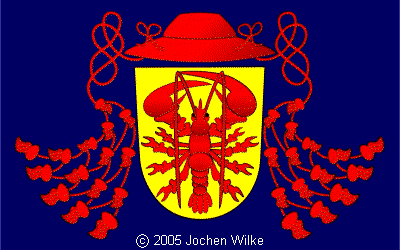Nicholas of Cusa
bore canting arms corresponding to his actual surname
(Krebs = "crayfish" or "cancer" in German).
His surname is variously spelled Cryffts, Chrypffs, Kryffs or Krebs.
Nikolaus was born in Kues
(now Bernkastel-Kues, 30 km NE of the German city of Treves, in the Rhineland-Palatinate)
to a wheatlhy family of merchants. As he entered the clergy, he became known as
Cusanus, after the Latin name of his birthplace.
Cusa received his doctorate in canon law from the University of Padua in 1423.
Cusa was ordained in 1440. He was created a cardinal by Pope Nikolaus V
on January 11, 1450.
The same year, he was entrusted with the bishopric of Brixen, South Tyrol
(called Bressanone in Italian)
where he opposed Archduke Sigismund of Austria who imprisoned him in 1460.
For this, the Duke was excommunicated (by Pope Pius II) but did not capitulate until 1464,
after Cusa's death.
Cusa thus never returned to his bishopric.
Cusa drew inspiration from a wide range of thinkers,
from Plato to
Ramon Llull (1232-1316).
However, he publicly attributed his original thoughts only to an illumination he had in 1437,
on his way back from Constantinople. He described this revelation as a gift from God.
(Incidentally, this made whatever he said more acceptable to his contemporaries.)
As a philosopher, a mathematician and an astronomer, Cusa held some revolutionary beliefs:
- Space is infinite.
Motion is relative.
- The Earth moves around the Sun, which is a star among others.
- Other inhabited worlds
may similarly orbit some stars.
Cusanus was the first to suggest the use of concave lenses to
relieve myopia.


